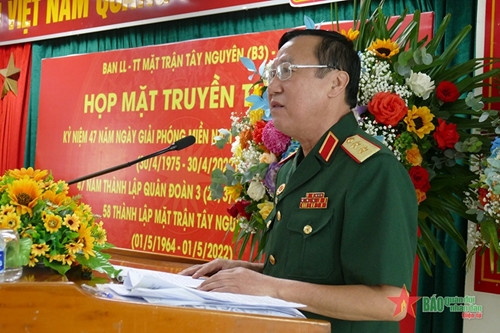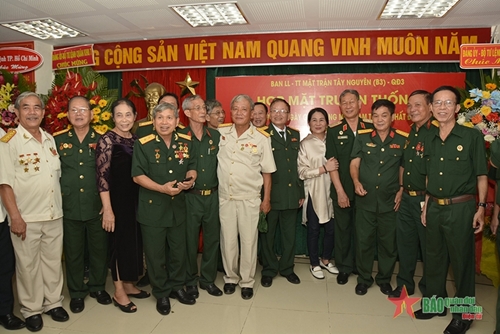    |
 |
|
Lt. Gen. Nguyen Duc Hai speaks at the meeting. |
The event was attended by heroes of the people’s armed forces, military generals from different periods, representatives from agencies and units inside and outside the military, and relatives of troops of the Central Highlands Front (predecessor of Army Corps 3).
At the meeting, delegates recalled the establishment and contribution of the Central Highlands Front to the resistance war for national independence. In particular, the Central Highlands Front was founded by the Politburo on May 1, 1964 and reinforced with regular units from the North, including Regiment 320, Regiment 101 under Division 325, Regiment 66, commando battalions, units from military regions, and experienced generals.
Speaking at the meeting, Lieutenant General Nguyen Duc Hai, former Commander of Army Corps 3 and former Director of Defense Ministry’s Institute of Strategy, recalled that together with troops and people across the country, troops of the Central Highlands Front bravely participated in and contributed to the success of Plei Me, Sa Thay, and Dak To - Tan Canh operations. They actively carried out international duties in Cambodia and took part in the Northern border defense war.
    |
 |
|
Delegates in a joint photo |
Troops of the Central Highlands Front greatly contributed to Buon Ma Thuot Victory, which was considered one of the greatest victories in the resistance war against U.S. invaders. Buon Ma Thuot Victory created springboard for our troops to win Tay Nguyen Victory on March 4, 1975, contributing to the Southern liberation.
After Saigon (present Ho Chi Minh City) was liberated, Army Corps 3 was tasked to manage Tay Ninh, Cu Chi, Hoc Mon, Tan Son Nhat Airport, and District 3, among others. The corps was then assigned to build political and local armed forces, participated in Southwestern border defense and Northern border defense wars, and carried out international duties in Cambodia.
In the national construction and defense cause, Army Corps 3 has always fulfilled assigned missions, building a revolutionary, regular, elite, and gradually-modernized army corps.
Translated by Tran Hoai